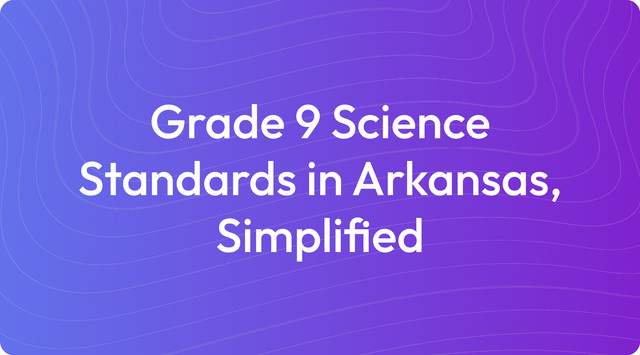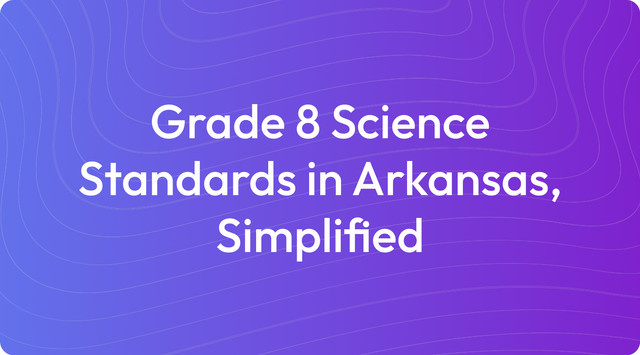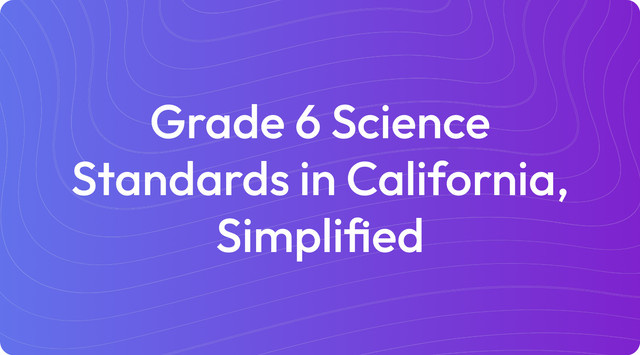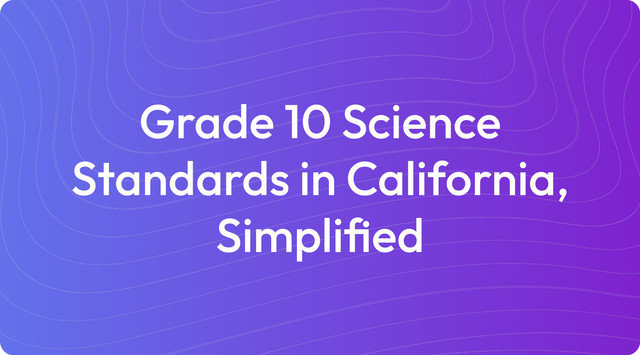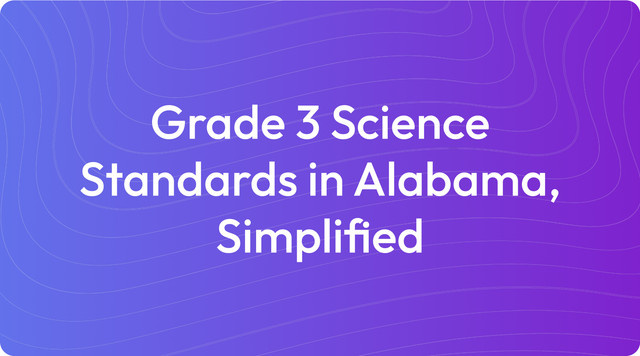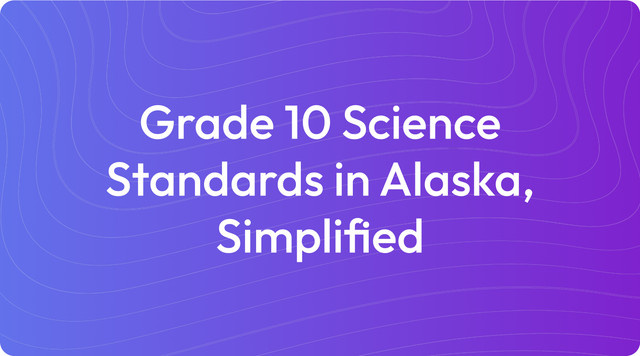Grade 11 Science Standards in Alabama, Simplified
Grade 11 science includes chemistry or physics—atoms, reactions, motion, and waves. Get clear standards—read more on TeachShare!
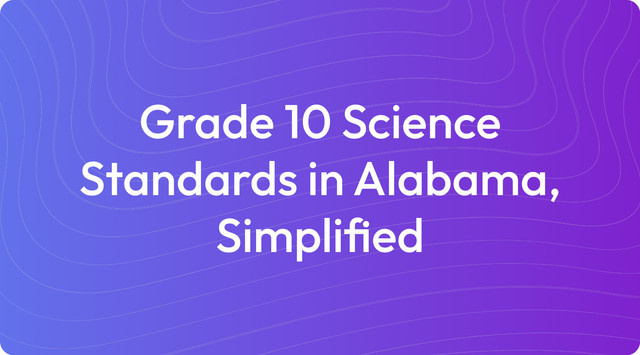
We understand that working with state education standards can be a complex part of lesson planning. Our goal is to provide clear, simplified versions of these standards to help you focus on what's most important: teaching. This resource is designed to give you a straightforward guide to the learning objectives for your students.
Education standards are a set of learning goals for what students should know and be able to do at each grade level. For teachers, they provide a clear framework for instruction without dictating specific teaching methods or materials. For example, the Grade 11 Science Standards in Alabama outline key concepts in Chemistry and Environmental Science, giving you the flexibility to design lessons that best fit your students' needs.
What Are Grade 11 Science Standards in Alabama?
The Grade 11 Science Standards for Alabama are based on the Alabama Course of Study and focus on either Chemistry or Environmental Science, depending on the course selected. These standards are built around scientific inquiry and hands-on investigation to help students connect complex scientific concepts to real-world applications. They are designed to develop critical thinking skills and explore how science relates to everyday life.
Here is a breakdown of the key areas and learning goals for Grade 11 Science:
Key Areas of Grade 11 Science Standards in Alabama (Chemistry Focus)
1. Structure of Matter
- Standard 1: Develop models to describe atomic structure, including protons, neutrons, and electrons, and how they determine the properties of elements.
- Standard 2: Use the periodic table to predict the properties of elements and their interactions based on their atomic structure.
2. Chemical Reactions
- Standard 3: Analyze and interpret data to identify evidence of chemical reactions, including changes in energy and the formation of new substances.
- Standard 4: Construct explanations for the law of conservation of mass and use balanced chemical equations to represent reactions.
3. Energy in Chemical Systems
- Standard 5: Plan and conduct investigations to demonstrate how energy is transferred or transformed in chemical processes (e.g., endothermic and exothermic reactions).
- Standard 6: Use models to explain bond formation, breaking, and energy changes in chemical reactions.
Key Areas of Grade 11 Science Standards in Alabama (Environmental Science Focus)
1. Earth’s Systems and Resources
- Standard 1: Develop models to explain the cycling of matter (e.g., carbon, nitrogen, water) and the flow of energy in ecosystems.
- Standard 2: Analyze data to determine how natural and human events affect Earth’s systems (e.g., climate change, deforestation).
2. Human Impact and Sustainability
- Standard 3: Design and evaluate solutions to reduce human impact on natural resources and ecosystems (e.g., pollution, habitat destruction).
- Standard 4: Investigate how renewable and nonrenewable resources are managed and how they affect ecosystems.
Key Learning Goals for Grade 11 Science in Alabama
- 1. Model and Explain: Students use models to explore atomic structure, chemical bonding, matter cycling, and energy flow.
- 2. Analyze Data: Students interpret experimental data to identify chemical reactions, energy changes, or environmental impacts.
- 3. Solve Real-World Problems: Students design solutions related to sustainability, energy efficiency, or resource management.
The framework for these standards is guided by the Alabama State Department of Education, drawing from principles outlined in national resources like the Next Generation Science Standards.
Key Tested Standards
For Grade 11 Science in Alabama, the key tested standards are drawn from the Alabama Course of Study: Science (2015). Depending on the course, the focus will be on either Chemistry or Environmental Science, assessing students' grasp of matter, chemical reactions, energy, ecosystems, and human impact. Below are the key tested standards for Grade 11 Science:
Key Tested Standards for Grade 11 Science (Chemistry Focus)
1. Structure of Matter
- Standard 1: Develop models to describe atomic structure, including protons, neutrons, and electrons, and how they determine an element’s properties.
Why It’s Key: This foundational standard helps students understand atomic behavior, which is crucial for grasping concepts like bonding and reactivity. - Standard 2: Use the periodic table to predict properties of elements and their interactions based on atomic structure.
Why It’s Key: This standard connects the periodic table to trends in reactivity, electronegativity, and ionization energy, essential for predicting chemical behavior.
2. Chemical Reactions
- Standard 3: Analyze and interpret data to identify evidence of chemical reactions (e.g., color changes, gas production, energy transfer).
Why It’s Key: Students learn to recognize and classify chemical changes, a critical skill for understanding how matter transforms. - Standard 4: Construct explanations for the law of conservation of mass and use balanced chemical equations to represent reactions.
Why It’s Key: This standard ensures students understand that mass is conserved and can quantify reactants and products in reactions.
3. Energy in Chemical Systems
- Standard 5: Plan and conduct investigations to demonstrate how energy is transferred or transformed during chemical reactions (e.g., endothermic and exothermic).
Why It’s Key: Students explore energy changes in reactions, linking chemistry to real-world applications like fuel efficiency. - Standard 6: Use models to explain bond formation, breaking, and energy changes in chemical systems.
Why It’s Key: Understanding chemical bonds and energy is essential for explaining reaction mechanisms and energy transfer.
Key Tested Standards for Grade 11 Science (Environmental Science Focus)
1. Earth’s Systems and Resources
- Standard 1: Develop models to explain the cycling of matter (e.g., carbon, nitrogen, water) and energy flow in ecosystems.
Why It’s Key: This standard helps students understand ecosystem sustainability and how human activities affect natural cycles. - Standard 2: Analyze data to determine how natural and human events affect Earth's systems, such as climate change or deforestation.
Why It’s Key: Students explore the impact of global issues like greenhouse gases and land use changes on ecosystems.
2. Human Impact and Sustainability
- Standard 3: Design and evaluate solutions to reduce human impact on natural resources and ecosystems (e.g., pollution, habitat loss).
Why It’s Key: This standard encourages students to apply science to create solutions for environmental challenges, fostering responsibility and innovation. - Standard 4: Investigate how renewable and nonrenewable resources are managed and their effects on ecosystems.
Why It’s Key: This standard encourages students to evaluate energy resources and their environmental trade-offs.
Why These Standards Are Key for Testing
These standards are considered key for testing because they assess a student's ability to perform essential scientific practices. These skills include:
- Analyze Data: Students must interpret experimental results, such as those from chemical reactions or climate data.
- Develop and Use Models: This involves creating representations like atomic structure diagrams or ecosystem cycle models.
- Construct Explanations: Students are expected to use evidence to explain phenomena like the conservation of mass or human environmental impact.
- Solve Real-World Problems: This skill focuses on designing solutions for challenges related to energy, pollution, or sustainability.
These standards are guided by both state and national frameworks. For specific details on Alabama's graduation requirements, you can visit the state's official education portal. The information presented here is based on resources from the Alabama State Department of Education and the Next Generation Science Standards.
Example Learning Objectives for Unit Planning
Learning objectives break down broad standards into specific, measurable goals for your students. They help clarify what students should be able to do by the end of a lesson, making it easier to plan activities and assessments.
Here are examples of learning objectives for two Grade 11 Science standards, written in student-friendly language and aligned with the Alabama Course of Study: Science (2015):
Standard: Use the periodic table to predict properties of elements and their interactions based on atomic structure (Standard 2, Chemistry Focus).
- I can explain how the arrangement of elements on the periodic table relates to their atomic structure.
- I can predict the reactivity of elements based on their position in the periodic table (e.g., groups and periods).
- I can use the periodic table to determine trends like electronegativity, ionization energy, and atomic radius.
- I can predict how elements will bond (ionic or covalent) based on their properties.
Standard: Analyze data to determine how natural and human events affect Earth’s systems (e.g., climate change, deforestation) (Standard 2, Environmental Science Focus).
- I can describe how human activities, like deforestation or pollution, impact Earth’s systems (e.g., water cycle, atmosphere).
- I can analyze data (e.g., graphs, maps) to identify trends in climate change, such as rising temperatures or increased CO₂ levels.
- I can explain how natural events, like volcanic eruptions, affect ecosystems and global temperatures.
- I can propose solutions to reduce human impacts on Earth's systems, like conserving energy or reducing waste.
Key Changes & Updates
The Grade 11 Science Standards in Alabama, based on the 2015 Alabama Course of Study, have been updated to place a greater emphasis on critical thinking and practical application. This shift encourages more hands-on, inquiry-based learning, where students actively conduct experiments and build models. The standards also now integrate real-world scenarios, connecting concepts in Chemistry and Environmental Science to everyday problems and global issues. Our goal with these changes is to help you make science more relevant and engaging for your students.
The updates also aim to build stronger analytical skills by focusing on data analysis and evidence-based reasoning. Students are guided to collect and interpret data to construct scientific explanations. There is also an increased focus on cross-disciplinary connections, such as using math to solve equations and literacy skills to present findings. In Chemistry, this means a deeper exploration of matter and energy, while Environmental Science now includes engineering principles to help students design solutions for challenges like pollution and resource conservation.
Create with TeachShare
We know that turning state standards into effective, engaging lesson plans is a demanding task. Our platform is designed to help you create high-quality, differentiated materials that meet specific curriculum requirements in just a few minutes. We combine AI with proven teaching strategies, giving you more time to focus on what matters most—your students. Start creating standards-aligned instructional resources with TeachShare now.
Frequently Asked Questions
How do the Alabama science standards encourage practical, hands-on learning?
The standards are designed to move learning beyond textbooks and into the real world. They promote a more active approach by emphasizing a few key areas:
- Hands-on learning where students conduct their own experiments and investigations
- Real-world applications that connect science to current issues like pollution and renewable energy
- Engineering integration that challenges students to design, test, and refine solutions to problems
- Critical thinking that requires students to analyze data and construct evidence-based explanations
What are the key differences between the Chemistry and Environmental Science pathways?
Students in Grade 11 focus on one of two distinct but equally important fields. Here’s a simple breakdown:
- Chemistry: This path centers on the building blocks of matter. Students explore atomic structure, chemical bonding, reactions, and the conservation of matter. Activities often involve lab experiments and calculating the results of chemical changes.
- Environmental Science: This path looks at the bigger picture of Earth’s systems. Topics include the cycling of matter, energy flow in ecosystems, and the impact of human activity. Students might build models of nutrient cycles or design solutions to reduce environmental harm.
How are students evaluated under these science standards?
Assessment is focused on what students can do with their knowledge. Instead of relying only on traditional tests, evaluations include a variety of performance-based tasks. Here are some examples:
- Investigations: Students conduct experiments on topics like chemical reactions or human impacts on ecosystems.
- Models and Projects: They create models to visualize concepts like atomic structures, food webs, or nutrient cycles.
- Data Analysis: Students are asked to interpret graphs, tables, and charts to identify trends and patterns.
- Explanations: They communicate their findings by writing evidence-based explanations for scientific phenomena.
Why is engineering a component of the science curriculum?
Including engineering helps bridge the gap between scientific theory and practical application. It is included to teach students how to use science concepts to solve real-world problems. This approach develops creativity and critical thinking by having students design, test, and refine their own solutions, highlighting the important connection between science and technology.
What are some effective ways to make these science topics engaging for students?
We know that keeping students engaged is key to deep learning. Here are a few proven strategies you can use in the classroom:
- Use real-world examples that students can relate to, like discussing how chemical reactions power cars or how to conserve energy at home
- Incorporate hands-on activities, such as experiments, model-building, or simulations, to explore abstract concepts
- Encourage collaborative problem-solving through group projects where students design solutions together
- Use technology like virtual labs, interactive videos, or graphing tools to make learning more accessible and visual
Answer


